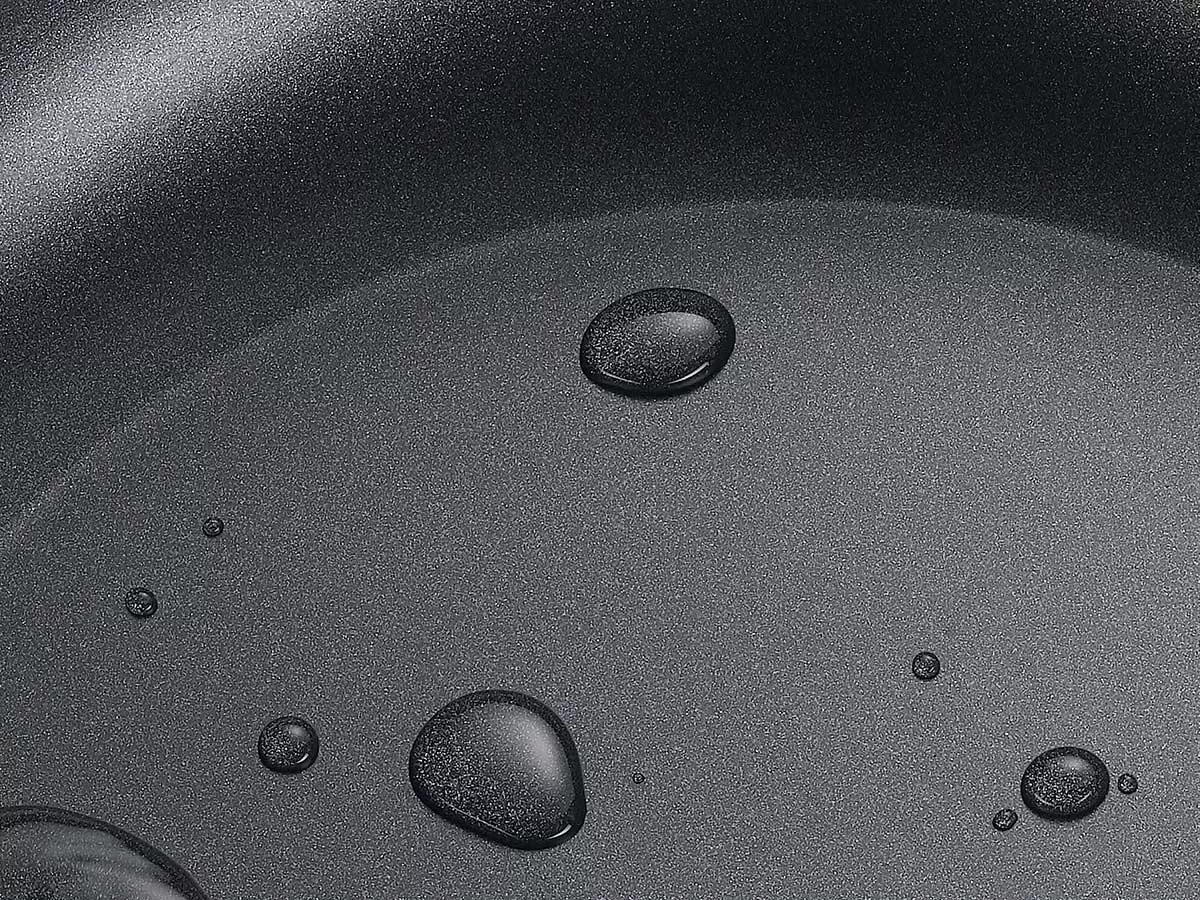In recent years, the global residential kitchen cookware market has seen a notable shift towards customized solutions, as consumers seek personalized cookware sets that fit their unique cooking styles and preferences (source). This trend is driven by the realization that one-size-fits-all non-stick coatings often fail to deliver optimal performance across different cooking methods and food types.
Traditional non-stick coatings, while convenient for general cooking, can struggle when faced with specific challenges such as high-heat searing, delicate baking, or the rigors of braising and grilling. As a result, home cooks and professional chefs alike are seeking cookware with customized non-stick coatings that are tailored to their specific needs, ensuring superior cooking performance, easy cleanup, and extended product lifespan.
Understanding Non-Stick Coating Types
Non-stick coatings come in various forms, each with its own unique properties, advantages, and drawbacks. The most common types include:
PTFE (Teflon): Developed by DuPont, PTFE is a synthetic polymer that creates an incredibly slick surface. It's highly heat-resistant (up to 500°F/260°C) and virtually scratch-proof. However, it can release toxic fumes when overheated and has faced environmental concerns (Source).
Ceramic: Made from sand and a sol-gel solution, ceramic coatings are a more eco-friendly alternative to PTFE. They're PFOA-free, oven-safe up to 800°F (427°C), and easy to clean. However, they can be less durable and prone to chipping or cracking over time .
Enameled Cast Iron: Cast iron pans are coated with a vitreous enamel glaze, creating a non-stick surface that is incredibly durable and resistant to chipping or peeling. The downside is that enameled cast iron is heavy and can be prone to cracking if subjected to sudden temperature changes.
Anodized Aluminum: Through an electrochemical process, the aluminum surface is oxidized to create a harder, more durable non-stick coating. Anodized aluminum is relatively inexpensive, scratch-resistant, and easy to clean. However, it may not perform as well as PTFE or ceramic at higher temperatures.
Optimizing for Frying and Searing
When it comes to frying and searing, the key is a non-stick coating that can withstand high heat without breaking down or causing food to stick and scorch. The best coatings for these cooking methods are typically made from PTFE (like Teflon) or anodized aluminum.
PTFE coatings like those found on the Food Network's top-rated non-stick frying pans can withstand temperatures up to 500°F, making them ideal for getting a great sear on meats or frying at high heat. The downside is that these coatings can break down over time and release potentially harmful fumes if overheated.
Anodized aluminum is another excellent option, with an oxidized surface layer that is essentially non-stick and can handle temperatures over 600°F. As one Redditor notes in this thread, reinforced non-stick aluminum pans like those from Le Creuset can provide outstanding high-heat performance for searing and frying without sticking or hot spots.
Optimizing for Baking
When it comes to baking, achieving even heating and easy release of baked goods are paramount. Customized non-stick coatings can be optimized to promote uniform browning and prevent sticking, ensuring your cakes, breads, and pastries come out perfectly every time. According to LloydPans, their durable permanent release coatings eliminate the need for reglazing and reduce the use of release aids, lasting through countless baking cycles with proper care.
Durability is also a key factor for baking coatings, as they must withstand repeated heating and cooling cycles without chipping or flaking. Fluorotec specializes in PTFE coatings for commercial bakeware, providing a cost-effective solution that extends the lifespan of equipment compared to silicone glazes. With a customized non-stick coating optimized for baking, you can achieve consistent results while reducing maintenance and replacement costs.
Optimizing for Braising
For braising, durability and corrosion resistance are key considerations when selecting a non-stick coating. The coating needs to withstand extended exposure to liquid and acidic ingredients at high temperatures. Enameled cast iron, like the DASH Zakarian 4.5Qt Nonstick Cast Iron Braiser, excels in this area. The enamel coating protects the cast iron from reacting with acids while providing a non-stick surface that releases braised dishes easily. As Bon Appétit notes, the porcelain enamel isn't just for looks - it makes the cookware rust-resistant and non-reactive to acidic foods.
Cleanup is also simplified with the right non-stick coating for braising. A high-quality, durable coating prevents stubborn stuck-on messes. This saves time and effort when washing up after a labor-intensive braise.
Optimizing for Grilling
When it comes to grilling, the ideal non-stick coating needs to withstand high heat while preventing food from sticking to the grates. Flare-ups are also a concern, as dripping fats and oils can cause dangerous flare-ups. To address these challenges, coatings optimized for grilling prioritize high heat tolerance and superior non-stick properties.
According to Made In Cookware, carbon steel is an excellent naturally non-stick option for grilling due to its ability to withstand extremely high temperatures without degradation. The surface actually becomes more non-stick over time through seasoning. Ceramic coatings can also offer good heat resistance and non-stick performance, though they may be more prone to chipping or scratching on grill grates.
To minimize flare-ups, look for coatings that create a smooth, non-porous surface. This prevents fats and oils from seeping in and causing sudden flare-ups when dripping. ILAG's FAQ recommends avoiding non-stick coatings above 250°C (482°F) for extended periods, as this can cause coating breakdown and increased sticking. For quick searing over high heat, however, premium non-stick coatings like those used by Tefal Unlimited can tolerate brief exposure to temperatures up to 450°C (842°F).
Temperature Range Considerations
When selecting a non-stick coating for cookware, it's crucial to match the coating's temperature limits to the typical cooking temperatures required. As highlighted in A Brief Guide to High Temperature Coatings, coatings can degrade or fail when exposed to excessive heat beyond their rated limits. Common cooking methods like searing and frying require coatings able to withstand temperatures up to 500°F, while baking and braising may only need coatings rated for 400°F or lower.
Selecting a coating with an appropriate maximum temperature rating helps prevent degradation, discoloration, or release of harmful compounds. How Temperature Impacts Industrial Coating Performance notes that going below the optimal curing temperature can also lead to issues like poor adhesion and sagging. Customizing the coating formulation to match your typical cooking temps ensures optimal performance and longevity.
Food Type Considerations
Different non-stick coatings perform better with certain types of foods based on their chemical makeup. Acidic foods like tomatoes or citrus can cause premature degradation of some non-stick surfaces. According to San Francisco's Department of the Environment, PTFE (Teflon) coatings are not ideal for cooking acidic or alkaline foods, as they can break down the coating over time.
Sticky foods like sugary sauces or caramelized dishes also pose a challenge for some non-stick surfaces. Ceramic coatings tend to perform well with these types of foods, as their hardened surface releases sticky residues more easily than traditional PTFE. For baking applications where you'll be working with doughs, batters, or sugary toppings, a reinforced ceramic or enameled cast iron coating may be the optimal choice.
Prioritizing Ease of Cleaning
When selecting a custom non-stick coating, ease of cleaning should be a top priority. Smooth, glossy surfaces tend to be easier to wipe clean than textured coatings. However, some textured ceramic coatings are designed for effortless food release, like the "Artistry Non Stick Fry Pan" from Ecolution.
Dishwasher-safe cookware like Ecolution's ceramic set offers maximum convenience, but handwashing is recommended for longevity. Follow Better Homes & Gardens' tips – make a baking soda paste to gently scrub away stuck-on food without damaging the coating.
Evaluating Durability and Lifespan
The longevity of a non-stick coating largely depends on its thickness and the treatment of the cookware surface. Thicker coatings tend to resist abrasion and wear better over time. Some manufacturers reinforce the coating with additional layers or particles to enhance durability. For example, ceramic-reinforced non-stick surfaces can extend the lifespan to 2-3 years with proper care (Source).
Proper use and cleaning methods also play a crucial role. Avoiding metal utensils, high heat, and abrasive scouring pads can prevent premature degradation of the non-stick surface. Hand washing is recommended over dishwashers to preserve the coating integrity (Source). With diligent care, even budget stainless steel cookware can have an extended usable life (Source).
Eco-Friendly Coating Options
As consumers become more conscious of the environmental impact of their purchases, eco-friendly non-stick coatings have gained popularity. Traditional PTFE (Teflon) coatings contain perfluorooctanoic acid (PFOA), a synthetic compound that may pose health risks and is harmful to the environment (source). Fortunately, there are now several PFOA-free and more sustainable options available:
Ceramic non-stick coatings are made from inorganic materials like silicon and titanium, making them more environmentally friendly than traditional PTFE. Brands like Xtrema use renewable raw materials and green manufacturing practices to create durable, non-toxic cookware (source). Other eco-conscious choices include cast iron, carbon steel, and enameled cast iron, which can develop a natural non-stick patina over time without the need for synthetic coatings.
New Innovations in Coating Customization
The world of non-stick coatings is rapidly evolving, with new innovations allowing for unprecedented levels of customization. One exciting development is the emergence of new application methods that enable coatings to be applied more precisely and evenly, resulting in improved performance and durability. For example, advanced vapor deposition techniques can create ultra-thin, uniform coatings with superior non-stick properties.
Another area of innovation is the development of hybrid coatings that combine the strengths of multiple materials. By blending different non-stick compounds, manufacturers can create coatings tailored to specific cooking needs. For instance, a hybrid coating might incorporate ceramic particles for enhanced heat resistance while maintaining the exceptional release properties of traditional PTFE (Source).
Perhaps most exciting are the advancements in "tunable" coatings, which can be adjusted to meet the unique requirements of each customer or cooking application. These coatings leverage advanced materials and manufacturing processes to precisely control properties such as surface texture, heat conductivity, and non-stick performance. By fine-tuning these characteristics, cookware manufacturers can create truly customized solutions that optimize the cooking experience for specific recipes, cooking styles, or personal preferences (Source).
Choosing the Right Custom Coating
Selecting the ideal custom non-stick coating requires careful consideration of your specific cooking needs and habits. Different coatings excel in various areas, so it's essential to weigh the trade-offs and prioritize the factors most important to you.
One key factor is the types of foods you typically prepare. If you frequently cook delicate items like eggs or fish, a ultra-smooth, low surface energy coating like PTFE may be optimal for easy release. However, if you often sear meats at high heat, a more durable ceramic or anodized aluminum coating could better withstand the high temperatures without degrading (Source).
Cleaning ease is another vital consideration. While some coatings release food effortlessly, others may require more elbow grease. Your tolerance for scrubbing baked-on messes should influence your choice. Durability is also crucial – if you want a coating to last for years, you may need to invest in a thicker, more robust option.
Contact Pfluon for your custom non stick coatings. We can tailor all the coatings based on your needs!





